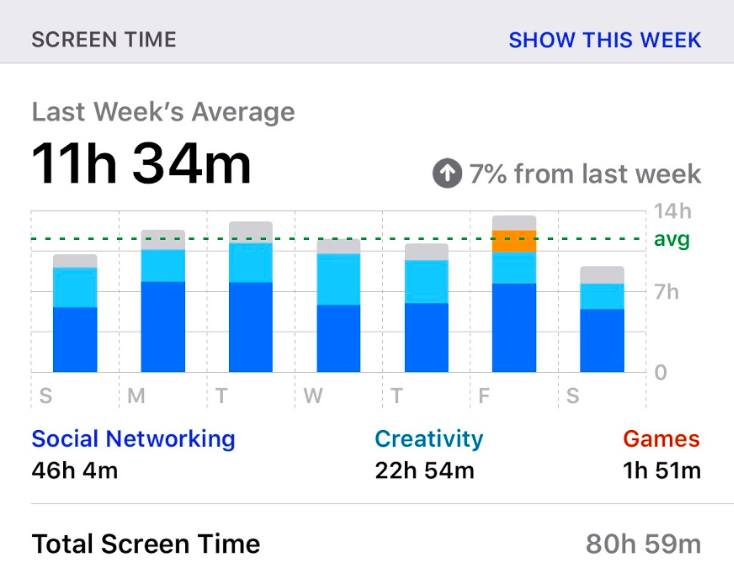Do you have any idea how much time you have been spending on your phone?
Photo Grace Friedberg
Screen time data for a full week
This pandemic has had a major effect on everyone, causing them to stay home and social distance. While everyone is home quarantining, it is to be expected that our screen time on electronic devices will go through the roof.
As schools are closed indefinitely and are switching to online classes, it is clear to see that students are going to have more exposure to computers and other devices. Specifically, WHS requires a maximum of two hours per week for each class’s homework and assignments. But, in reality, I am personally assigned way more work than that. With all the assignments being posted virtually and completed over a computer, for me the two hours of screen time extends to four or more hours per class.
When the designated time slots for virtual classes to take place are completed, students tend to spend additional time on their phones by either scrolling through social media, binge watching the latest Netflix series or staring at their tv screen as they place #1 in Fortnite. According to medlineplus.gov, too much screen time can potentially raise health concerns such as anxiety, depression and difficulties when falling asleep at night.
Despite all the time I spend on my computer completing my school work, I find myself spending the most time on my electronic devices at night. I tend to spend between one to three hours on my phone right before I go to bed causing me to stay up very late. To say the least, this has a negative effect on my sleep schedule as I end up sleeping in the next morning due to the fact that I was up all night on my phone.
While in quarantine, I noticed over the past few weeks that I was never tired at night, so because of this I would stay awake and either go on my phone or computer. I decided to look up why I couldn’t fall asleep and I came across a potential reason for my insomnia. According to sleep.org, a blue light is emitted by screens on all electronic devices. This light prevents the production of melatonin, which is the hormone that regulates your sleep-wake cycle. The reduction of this hormone makes it harder to fall asleep.
After discovering my reasoning for having a tough time falling asleep, I came across the “Screen Time” feature on the settings app of my iPhone, where I was able to see how much time I was spending on my device and ways to limit my usage. I gathered the data from last week and noticed that my daily average was 11 hours and 34 minutes of screen time. I was shocked to see how much time I spent on my phone per day as it varied from a minimum of nine hours to a maximum of 13 hours. Over the whole week I spent around 81 hours on my phone. That really concerned me as those statistics were only for my phone usage and did not take into account the amount of time I spent on staring at my television and computer.
Once I realized I spent an excessive amount of time staring at a screen, I discovered the control on your phone where you can limit the amount of time you spend on each app. I set a time limit for each app and when I reach the limit I get a notification that informs me to exit the app.
As the weather is getting nicer I have decided I need to put the devices down and spend more time outside. There are so many more things I could be doing instead of isolating myself inside and staring at my screen. I am determined to reduce my screen time and spend more time with my family or do something that doesn’t require technology, whether I walk my dog or go on a run.
After discovering how much time I spend on my screen, I realize I don’t want to limit myself to only staring at my phone all day. So with that being said, get off your device and be creative with all of this time we have been given!

